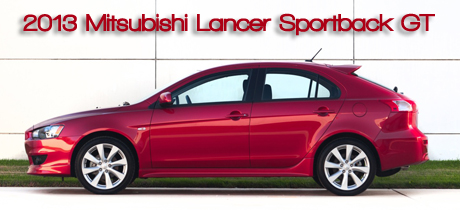
2013 Mitsubishi Lancer Sportback Road Test Review
By Bob Plunkett
Twisty kinks of serpentine asphalt on route 276, the Pisgah Highway which cuts across the Blue Ridge Mountains of North Carolina, show off sporty handling traits during our drive test of the 2013 Lancer Sportback GT, a compact-class five-door sport hatchback from Japan's Mitsubishi.
Hunkering low against the road and hugging hard through each tight curve, one Sportback carves a crisp and controlled line through each curve at a rather fast clip.
This latest iteration of Mitsubishi's hatchback series for Lancer does not protest our aggressive treatment in the driver's seat. Actually, it seems to invite even more action, and we of course comply.
Our test car on the Blue Ridge curve course rides on a rigid front-wheel-drive unibody platform that's strengthened and stiffened to achieve superior torsional rigidity. This chassis reinforcement checks the car body's tendency to sway laterally when steered through a curve so Lancer's passenger compartment remains tight and relatively flat.
Aiding this agile attitude, the platform's wide-track stance in conjunction with an independent front suspension system biased toward a low longitudinal roll center contribute predictable stability for Lancer Sportback. Likewise, the independent multi-link rear suspension holds back wheels in line while also damping vertical movement prompted by pavement bumps.
Driving the Sportback at a quick clip amounts to such excitement that upon reaching Brevard, perched just beyond fringes of the Chattahoochee National Forest, one driver pulls into a parking lot to catch a breath and also check out the razor-sharp styling of this car.
Even when parked on the lot, a Lancer Sportback looks like it’s racing at illicit speed.
On a rippled body the style seems aggressive, with wheels pinned at corners of the package to balance the stance. Body parts extend only briefly over front and back edges in the manner of racers as the prow and windshield tip rearward to suggest swift movement.
On flanks there's a high beltline with flares around the circular wheelwells plus shoulder bulges above the forward wheels.
Inspiration for that angular chin, wide-mouth trapezoidal grille gape and angry-eye headlamps stem from the menacing muzzle of a shark.
Lancer Sportback differs from a Lancer notchback sedan rearward of the C-pillar, where there's a sloping hatchback door with integrated roof wing. The door extends downward to the rear bumper to make loading gear so easy.
Compared to Lancer the sedan, there's more stow room inside with 13.8 cubic feet of space in the cargo compartment and split seatbacks on the second row that fold down to expand the back bay to 46.6 cubic feet.
There's enough room to house a bike, snowboards and boots or a heap of backpack gear.
The cabin layout shows two buckets up front, the back bench split 60/40 with room for three, and aft cargo area.
Lancer's dash is clean and uncluttered with the instrument panel tucked below a double-bubble cowl and binnacles housing the analog tachometer and speedometer.
Passengers are surrounded by air bags, including multi-stage frontal air bags and side air bags for front seats along with curtain-style air bags tucked in the ceiling for all outboard seats. There's even an inflatable air bag ahead of the driver's knees.
Electronic hardware for safety aboard Lancer Sportback ranges from an anti-lock brake system (ABS) and electronic brake force distribution (EBD) to Active Stability Control (ASC) with Traction Control Logic (TCL).
Mitsubishi constructs the front-wheel-drive 2013 Lancer Sportback with two different four-cylinder engines in two trim designations: ES and GT.
Lancer Sportback ES model totes a 2.0-liter four-cylinder aluminum-block engine with dual overhead cams (DOHC) and the Mitsubishi Innovative Valve timing and lift Electronic Control (MIVEC) equipment. It produces 148 hp at 6000 rpm plus 145 lb-ft of torque at 4200 rpm and regulates the output through an advanced continuously variable transaxle (CVT).
Fuel consumption numbers with this powertrain add up to 24 mpg city and 32 mpg highway.
Lancer Sportback GT edition scores a DOHC 2.4-liter in-line-four with MIVAC gear and a Sportronic CVT with paddle shifters. Output rises to 168 hp at 6000 rpm and 167 lb-ft of torque at 4100 rpm, with fuel economy figures of 22/29 mpg (city/highway).
The 2013 Lancer Sportback ES issue is an exceptional value with a load of standard equipment that includes air conditioning, power controls for windows and exterior mirrors and door locks, the rear seatback split 60/40, auto-off halogen headlamps, variable intermittent windshield wipers, a remote keyless entry device, plug-in Thule roof rack sockets, and a four-speaker 140-watt AM/FM/CD/MP3 player with Digital Signal Processing (DSP).
The 2013 Lancer Sportback GT edition goes further with standard equipment like automatic climate controls, Mitsubishi's FAST-Key entry and engine starting with panic alarm, leather binding the steering wheel and shift knob, and a sound system with six speakers and FUSE hands-free link system for audio voice control.
Mitsubishi establishes a manufacturer's suggested retail price (MSRP) of $18,495 for the 2013 Lancer Sportback ES. Figures for Lancer Sportback GT begin at $21,495.
For more information on Mitsubishi cars, click here
|